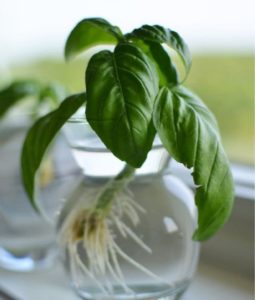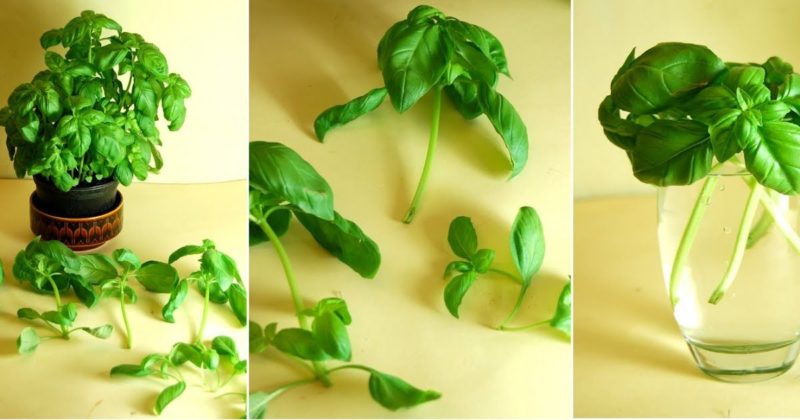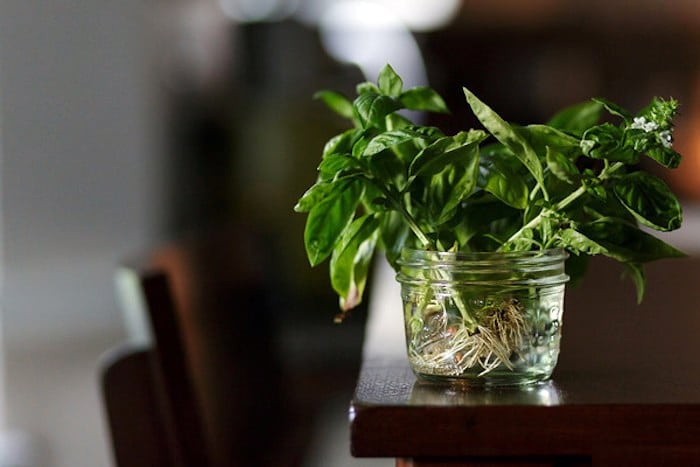A Guide to Taking Basil Cuttings for Beginner Gardeners
Basil - a spice in demand in Mediterranean cuisine, which is gradually becoming more and more popular in the world. Most gardeners grow this crop from seeds or buy seedlings. But there is a way to get basil faster, easier and cheaper. It involves the use of cuttings.
What is cuttings
Plants reproduce sexually and asexually. The latter is also called the vegetative method. In this case, cuttings are most often used. These are the separated parts of the plant (shoots or leaves).
Basil cuttings are vegetative propagation of a plant using cuttings.
Advantages and disadvantages of propagating basil from cuttings

The main advantages of propagating basil from cuttings:
- the method allows you to get new plants quickly and easily;
- one mother plant can produce many cuttings at once.
The only disadvantage is that you have to monitor temperature conditions. If the temperature drops below +20°C, approximately half of the cuttings will not grow roots.
Preparing containers
Basil is planted in 1.5-2 liter flower pots. They are first doused with boiling water to disinfect them.
Important! When growing basil, be sure to use a drainage layer of at least 3 cm. When water stagnates, the likelihood of development of diseases.
Ground
Basil grows best in light, fertile soil. Ready-made substrate is sold in specialized stores.
If you use soil from the garden, first water it with a solution of potassium sulfate or urea (1/8 tsp of the product is diluted in 1 liter of water). It is also advisable to disinfect the soil in the oven for 1 hour at 100°C.
Cherenkov
If you have neighbors or friends who already grow basil, the fastest method of propagation is cuttings. Some gardeners take cuttings from store-bought basil. The main thing is that it is fresh.
Cuttings are harvested from the lateral or upper shoots, about 6 cm long. Cut the branch close to the main stem. Cut at a slight angle to increase the cutting surface area. This will make it easier for the cutting to absorb water. Then the bottom pair of leaves is removed so that they do not rot in the water. This is also done to reduce the cuttings’ need for nutrients.
How to take basil cuttings

Prepared cuttings are placed in jars with water. It is important to remember that basil is a heat-loving crop. If the procedure is carried out in early spring, containers with shoots are placed on the most illuminated and warm windowsill. In summer, such problems do not arise.
It is advisable to change the water in jars daily. If the plant is warm enough, after about 7-10 days small white roots will begin to appear on the cuttings.
Important! If the cuttings are cold, roots will begin to form no earlier than after 20 days or will not form at all.
When the roots are 4-5 cm long, the plants are planted in containers with a nutrient substrate and a drainage layer. The soil should always be slightly moist. On dry soil, basil has stunted and small leaves.
Further care
The plant needs regular moderate watering to keep the soil slightly moist at all times. When grown indoors, overwatering will harm the basil.
If you accidentally flooded the soil and the plant began to become moldy, it is important to take appropriate action immediately. Remove infected stems and leaves to prevent the disease from spreading to healthy parts. After this, powder the soil with ash and loosen it.
Basil is fed once a month. To do this, use universal or organic fertilizers.
During cultivation, the soil is loosened regularly - every 3 days. Thanks to this procedure, a sufficient amount of air enters the soil, and the basil develops normally.
For more greenery, basil is recommended pinch. The first time this is done is when the plant has formed 6 leaves. The procedure is simple: the top of each sprout is cut off. After this, 2 branches will begin to form at once from the place of the cut. The procedure is repeated regularly.
How to grow basil from a sprig at home
Grow basil in a greenhouse or just open ground. But it is important to know some nuances.

In the greenhouse
After the roots have formed, the cuttings are transferred not to the pot, but directly to the greenhouse. This is done at the end of March or beginning of April (depending on weather conditions).
Basil is planted at a distance of 30 cm from each other. This is enough for the bushes to develop normally.
Watering is carried out as needed. The humidity in a greenhouse is usually high, so the soil takes longer to dry out than in open ground. It is also important to periodically ventilate the greenhouse to prevent mold from appearing.
In the open ground
Planting in open ground is carried out in late May or early summer. It is advisable to choose a place with fertile and breathable soil for the seedlings.It should also be well lit and protected from drafts.
If you plant basil in heavy soil, the plants will be weak or even die. The crop is grown on problem soil only if the area is first well fertilized with compost and peat, and also loosened with sand. This will make the heavy soil light and breathable.
Before planting basil, the soil is fertilized. For 1 sq. m add 1 bucket of humus and 200 g of wood ash.
Bushes are planted at a distance of 30-40 cm from each other. Planting is carried out in the evening or on a cloudy day.
In the first 2 weeks, when the temperature drops below +20°C, the plantings are covered with plastic film. Once the seedlings take root, this is no longer necessary.
Conclusion
Basil is most often grown from seeds but cuttings make it possible to obtain an adult plant much faster and easier. In addition, when using this method, it is possible to grow basil even from branches purchased in the supermarket.